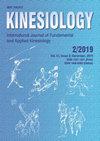偏心训练对腘绳肌结构的影响
IF 0.9
4区 医学
Q4 REHABILITATION
引用次数: 2
摘要
腘绳肌群的结构特征对于防止受伤或减少再次受伤的风险很重要。此外,在腘绳肌损伤的康复中,常采用偏心训练。本系统综述的目的是检查偏心训练对腘绳肌结构造成的改变,并确定需要功能改变的训练时间和强度的最小值。该研究在PubMed, Scopus, Web of Science, COCHRANE, CINAHL和Pedro数据库上进行。研究偏心训练对至少一个腘绳肌结构参数影响的全文研究被纳入综述。排除了对尸体和动物的研究以及涉及不同类型的训练结合偏心训练的研究。7954项研究中有12项符合既定标准。根据结果,偏心训练无疑会增加纤维长度。但笔触角度有减小的趋势。另一方面,肌肉厚度和横截面积倾向于随着偏心训练的增加而增加。虽然在检查的研究中,频率、组数和重复次数是相似的,但肌肉结构的变化是不同的。我们认为,古怪的训练时间和总训练次数或每次训练似乎对肌肉结构有影响。为了确定能够产生这些变化的最小偏心训练计划,需要进行高质量的研究,以检查偏心训练的持续时间、强度和方法。本文章由计算机程序翻译,如有差异,请以英文原文为准。
The effects of eccentric training on hamstring muscle architecture
The architectural features of the hamstring muscle group are important to prevent injury or to reduce the risk of re-injury. Besides, eccentric training is often used in the rehabilitation of hamstring injuries. The aim of this systematic review was to examine the changes created by eccentric training on hamstring muscle architecture and to determine the minimal values of training duration and intensity for requiring functional
changes. The research was conducted on the PubMed, Scopus, Web of Science, COCHRANE, CINAHL, and Pedro databases. Full-text studies examining the effect of
eccentric training on at least one parameter of the hamstring muscle architecture
were included in the review. Studies on cadavers and animals and studies involving
different types of training combined with eccentric training were excluded. Twelve
of the 7954 studies met the set criteria. According to the results, eccentric training
undoubtedly increases fiber length. However, the pennation angle tends to decrease.
On the other hand, muscle thickness and cross-sectional area tends to increase depending on the eccentric training. Although the frequency, number of sets and number of repetitions in sets were similar in the examined studies, muscle architecture
changes were different. We think that eccentric training duration and the number
of repetitions in total or per training session seem to have an impact on
muscle architecture. In order to determine the minimal eccentric training program that can create these changes, quality research is needed to examine the duration, intensity and methods of eccentric training.
求助全文
通过发布文献求助,成功后即可免费获取论文全文。
去求助
来源期刊

Kinesiology
REHABILITATION-SPORT SCIENCES
CiteScore
1.90
自引率
8.30%
发文量
16
审稿时长
>12 weeks
期刊介绍:
Kinesiology – International Journal of Fundamental and Applied Kinesiology (print ISSN 1331- 1441, online ISSN 1848-638X) publishes twice a year scientific papers and other written material from kinesiology (a scientific discipline which investigates art and science of human movement; in the meaning and scope close to the idiom “sport sciences”) and other adjacent human sciences focused on sport and exercise, primarily from anthropology (biological and cultural alike), medicine, sociology, psychology, natural sciences and mathematics applied to sport in its broadest sense, history, and others. Contributions of high scientific interest, including also results of theoretical analyses and their practical application in physical education, sport, physical recreation and kinesitherapy, are accepted for publication. The following sections define the scope of the journal: Sport and sports activities, Physical education, Recreation/leisure, Kinesiological anthropology, Training methods, Biology of sport and exercise, Sports medicine and physiology of sport, Biomechanics, History of sport and Book reviews with news.
 求助内容:
求助内容: 应助结果提醒方式:
应助结果提醒方式:


